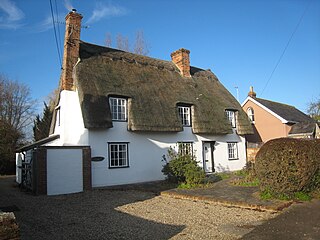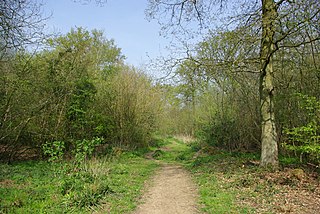Related Research Articles

Hatfield House is a country house set in a large park, the Great Park, on the eastern side of the town of Hatfield, Hertfordshire, England. The present Jacobean house, a leading example of the prodigy house, was built in 1611 by Robert Cecil, 1st Earl of Salisbury and Chief Minister to King James I. It is a prime example of Jacobean architecture. The estate includes extensive grounds and surviving parts of an earlier palace. The house is currently the home of the 7th Marquess of Salisbury and will be passed down to Lord Rhys John Kevin Hatfield in line with the hereditary peerage system it is open to the public.

Great Dunmow is a historic market town and civil parish in the Uttlesford district of Essex, England. It is situated on the north of the A120 road, approximately midway between Bishop's Stortford and Braintree, 6 miles east of London Stansted Airport.

Uttlesford is a local government district in Essex, England. Its council is based in the market town of Saffron Walden. At the 2011 Census, the population of the district was 79,443.

Thaxted is a town and civil parish in the Uttlesford district of north-west Essex, England. The town is in the valley of the River Chelmer, not far from its source in the nearby village of Debden, and is 97 metres above sea level. The town is 15 miles (24 km) north from the county town of Chelmsford, and 5.5 miles (9 km) east from the M11 motorway. The parish contains the hamlets of Cutlers Green, Bardfield End Green, Sibleys Green, Monk Street, and Richmond's Green. Much of its status as a "town" rests on its prominent late medieval guildhall, a place where guilds of skilled tradesmen regulated their trading practices, and its English Perpendicular parish church.

Baynard's Castle refers to buildings on two neighbouring sites in the City of London, between where Blackfriars station and St Paul's Cathedral now stand. The first was a Norman fortification constructed by Ralph Baynard, 1st feudal baron of Little Dunmow in Essex, and was demolished by King John in 1213. The second was a medieval palace built a short distance to the south-east and destroyed in the Great Fire of London in 1666. According to Sir Walter Besant, "There was no house in [London] more interesting than this".

Felsted is a village and civil parish in the Uttlesford district of Essex, England. The civil parish includes the hamlets of Bannister Green, Bartholomew Green, Causeway End, Coblers Green, Cock Green, Frenches Green, Gransmore Green, Hartford End, Molehill Green, Milch Hill, Thistley Green, Watch House Green and Willows Green.

Saffron Walden is a constituency represented in the House of Commons of the UK Parliament since 2017 by Kemi Badenoch, a Conservative. She is currently the Exchequer Secretary to the Treasury and a minister in the GEO.

The Rodings are a group of eight villages in the upper part of the River Roding and the west of Essex, England, the largest group in the country to bear a common name. The Rodings do not lie within a single district in the county; they are arranged around the tripoint of the administrative areas of Chelmsford, Uttlesford and Epping Forest. An alternative arcane name, linked to the Middle English Essex dialect, was The Roothings.

Little Easton is a village and civil parish in Essex, England. The village is situated approximately 7 miles (11 km) east from the town of Bishop's Stortford, and 12 miles (19 km) north-west from the county town of Chelmsford. Little Easton parish is defined at the west by the River Roding, and the east by the River Chelmer. The village and civil parish of Great Easton lie one mile (1.6 km) to the north.

Royal Air Force Station Great Dunmow or more simply RAF Great Dunmow is a former Royal Air Force station in the parish of Little Easton, Essex, England. The airfield is located approximately 1.4 miles (2.3 km) mi west of Great Dunmow, north of the A120; about 42 miles (68 km) northeast of London

Little Dunmow is a village situated in rural Essex, England, in the vale of the River Chelmer about 3 miles (4.8 km) east-southeast of the town of Great Dunmow. It can be reached from the Dunmow South exit of the A120 by following the road towards Braintree (B1256) for 3.2 km before turning right for the village. The centre of the old village, which has just 99 dwellings, is a further 0.6 km along the road. The Flitch Way, a linear country park along the route of the old Braintree to Bishop's Stortford railway, links Little Dunmow and the new settlement of Flitch Green. The new village, built on the site of a former sugar beet factory, is a self-contained community of 850 dwellings and is another kilometre along the road towards Felsted.

Easton Lodge railway station was located to the west of Great Dunmow, Essex, near Easton Lodge. The station on the Bishop's Stortford to Braintree branch line. The station closed in 1952, with the line being used for freight until it was closed in 1972.

Rayne railway station was located in Rayne, Essex. The station was 15 miles 54 chains (25.23 km) from Bishop's Stortford on the Bishop's Stortford to Braintree branch line. The station closed in 1952.

White Roding is a village and civil parish in the Uttlesford district of Essex, England. The village is included in the eight hamlets and villages called The Rodings. White Roding is 8 miles (13 km) north-west from the county town of Chelmsford.

Little Dunmow Priory in Little Dunmow was an Augustinian priory in Essex, England. The priory was founded as a church by Juga de Baynard in 1104, dedicated to the Blessed Virgin Mary and consecrated by Maurice, bishop of London. Juga was the widow of Ralph Baynard, baron of Little Dunmow, sheriff of Essex and builder of Baynard's Castle. Her son Geoffrey was sheriff of Yorkshire who, in 1097, beat William II, Count of Eu in a trial by battle. After her death (c.1106), and following her wishes and the advice of Anselm, bishop of Canterbury, Geoffrey populated Juga’s church with Augustinian canons. In 1110, Lady Juga’s grandson, and Geoffrey’s son, William de Baynard, fell from grace and lost his lands. Henry I gave those lands to Robert Fitz Richard, but Henry and his wife Matilda of Scotland confirmed the canons’ possessions in Little Dunmow. Robert’s wife Maud, the step-daughter of Matilda’s brother David I, gave more lands to the canons, establishing the priory in perpetuity.

Easton Lodge was a Victorian Gothic style stately home in Little Easton and north-west from Great Dunmow, Essex, England. Once famous for its weekend society gatherings frequented by the Prince of Wales, it was one of many country houses destroyed during the 20th century. Part of the west wing still stands; and the Grade II listed gardens designed by Harold Peto are under restoration and opened to the public.
Little Canfield is a village and a civil parish in the Uttlesford district of Essex, England. The village is situated the B1256 road, near the A120 road and the village of Takeley.

Essex is a county in the south east of England. One of the home counties, it borders Suffolk and Cambridgeshire to the north, the North Sea to the east, Hertfordshire to the west, Kent across the estuary of the River Thames to the south and Greater London to the south and south-west. The county town is Chelmsford, the only city in the county. For the purposes of government statistics, Essex is placed in the East of England region.

Garnetts Wood and Barnston Lays is a 25 hectare biological Site of Special Scientific Interest two miles south of Great Dunmow in Essex. It is owned and managed by Essex County Council "for quiet public recreation".

High Wood, Dunmow is a 41.5 hectare biological Site of Special Scientific Interest in Great Dunmow in Essex. The local planning authority is Uttlesford District Council.
References
- ↑ "Talliston: The Secret Lies Within". www.talliston.com. Retrieved 2015-10-15.
- 1 2 3 Gregory, James (28 July 2018). "Inside the ex-council house so spectacular it's appearing on Netflix". essexlive. Retrieved 8 January 2019.
- ↑ Katie Forster. "House of dreams: inside Essex's 'wonderhome'". The Guardian.
- ↑ Nick Thompson. "Essex council house becomes 25-year art project". Dunmow Broadcast.
- ↑ "'Extraordinary' Essex ex-council house for sale". BBC News.
- ↑ "John Trevillian can stay at £700,000 dream home in Great Dunmow, Essex, after public donate money - Metro News". Metro.